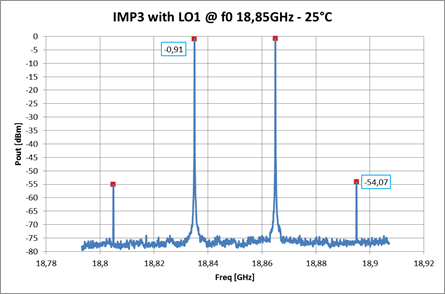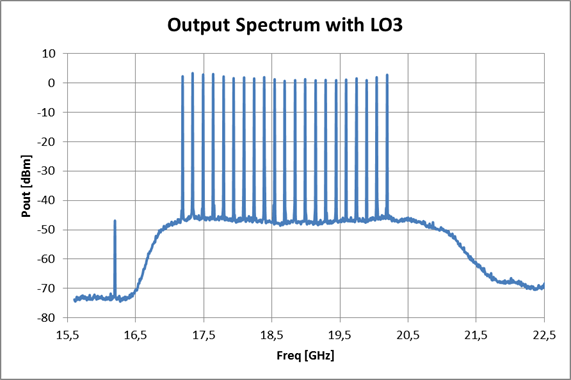
-
StatusCompleted
-
Status date2022-03-29
-
Activity Code5C.363
The objective of the WAKA project is to design, build, and test an Engineering Model of the RF line-up of a W to Ka-band frequency converter for future telecom payloads.
The targeted improvement is an enabling technology for future telecom systems based on the use of W-band for the gateway links.
In addition to the above objectives as per ESA-ITT, a low noise amplification section before the conversion mixer is designed and tested.
Therefore the unit under development is a full, standalone telecom receiver providing low noise amplification and down conversion to the Ka user band.
The project main tasks:
-
Identification of the technology/processes to be exploited for the design of the Down Converter.
-
Definition of the specifications and architecture, with reference to telecom programs of interest.
-
Identification, design and test of the critical building blocks and elements.
-
Design, manufacturing and test of elements of the RF line-up.
-
Design, manufacturing and test of the Down Converter.
The project objective is to design a W to Ka-band frequency converter with Ka-band devoted to the user segment and W-band devoted to the gateway one, by using European state-of-art MMIC technology.
Such converter provides similar performances to current 30/20GHz and 50/20 GHz ones’, in order not to degrade the signal received by the user terminal.
While TAS-I can boast a considerable heritage in design and production of IF line-up in Ka-band, the main challenges refer to the development of the new elements operating in W-band, in particular on the design of several MMICs operating at W-band high frequencies.
In the frame of ultra-high throughput satellite systems, targeting capacity higher than Terabits per second, a central question refers to the gateway traffic.
When Telecom system architecture based on star concept are involved, the capacity of a subset of beams has to be routed to the gateway, so that the more is the bandwidth available for the gateway the lower is the number of gateways, and therefore the cost of the system.
Currently, Q/V-to-Ka frequency converters are investigated mainly to exploit the entire Ka band for the user segment, thus enlarging the user segment instead of the gateway one.
However, it is also important to enlarge the gateway segment capacity (either in terms of number or in capacity of each gateway link).
Optical communications are for sure the answer to this needs, but they are still not mature. Therefore, it is reasonable to explore an intermediate step, represented by the WAKA converter, that by moving the gateway segment to the W-band can benefit of an available band which is roughly twice the one available in Q/V one and, at the same time, the number of the user beams associated with a single gateway is almost doubled as well.
The main features of the WAKA converter are here reported.
According to the specification requirements, the input frequency range is 81 to 86 GHz to be down-converter to 17.2 to 20.2 GHz.
Reported testing are relevant to following frequency plans:
LO1 freq.= 15.95GHz; RF range= 81-84GHz; IF=17.2-20.2GHz
LO2 freq.= 16.45GHz; RF range= 83-86GHz; IF=17.2-20.2GHz
LO3 freq.= 16.20GHz; RF range= 82-85GHz; IF=17.2-20.2GHz

Gain is above 65dB and gain flatness less than 1.0dBpp.
The Noise Figure performance is reported below at 25°C. The achieved figure is between 5 and 6dB. At hot temperature, 65°C the NF increased by about 1dB.

The linearity performance of the converter is verified by means of the two-tone test presented in the next figure. Third intermodulation tones are below -50dBc at the maximum output power.

The output spectrum for LO3 is presented below. 21 frequency tones within the useful band are applied and intermodulation products and spurious signals are sought.

No undesired signals are found. The out of band tone is LO3, which level is less than -40dBm.

The complete block diagram of the W to Ka-band Receiver/Converter is presented in Figure 5.
The line-up is completed with the input WR12 isolator that guarantees input matching, the hermetic waveguide to microstrip transition and the IF line-up in Ka-band already available from heritage designs.
After the mixer, a 3dB pad is used to improve the matching of the mixer and keep at low level the intermodulation products.
A proprietary Ka-band low noise amplifier (LNA 7531) is used to increase the gain by 22dB followed by a microstrip filter that rejects the out-of-band intermodulation products and LO harmonics.
A Voltage Variable Attenuator(VVA) follows, which task is to compensate the gain variations with temperature. The VVA is driven by a DC network based on one thermistor and several Selected on Test resistors, implemented on a PCB located outside the RF hybrid module.
A further gain stage follows, i.e. the MMIC amplifier, providing 19dB gain. In order to adjust the in-band gain flatness, a suitable flatness equalizer MIC is employed. Good matching is ensured by its balanced configuration.
Finally, a balanced amplifier is used at the output to provide 18dB of linear gain.
The project is organised in seven main work packages:
WP 1000: Project Management
WP 1100: Baseline Specifications
WP 1200: Critical Elements Design
WP 1300: Critical Elements MFG & Test
WP 1400: RF line-up Design
WP 1500: RF Line up MFG & Test
WP 1600: Overall evaluation
The project milestones are:
-
Kick-off Meeting (KOM);
-
Preliminary Design Review (PDR);
-
Detailed Design Review (DDR);
-
Test Review Board (TRB);
-
Final Review (FR).
The project has been concluded.
The results achieved are more than satisfactory:
-
The measured performances of the Receiver are well predicted by simulation and mostly in spec with the requirements.
-
The MMIC building blocks perform in good agreement with requirement.
-
The macro-hybrid module housing the Receiver includes a novel, low loss and hermetic waveguide-to-microstrip transition, which is compliant with the space environmental requirements.
Even though W-band is not deployed yet for satellite communication (gateway links), Thales Alenia Space Italia is committed in developing the basic building blocks of the RF sections of the payload, which include the W-band Receiver.




